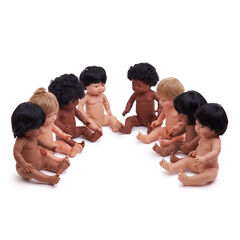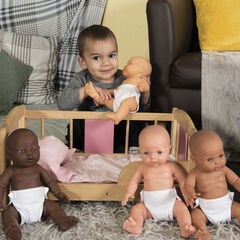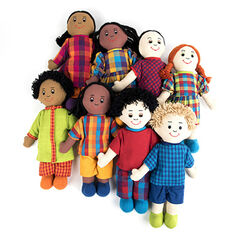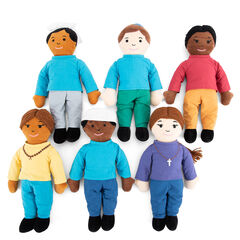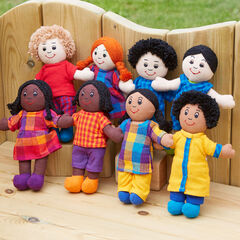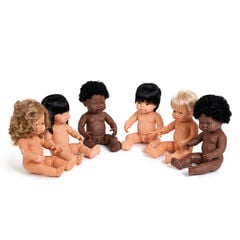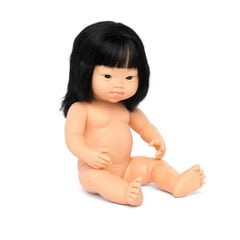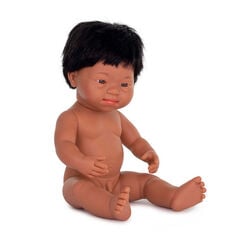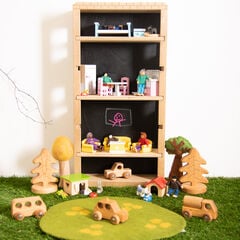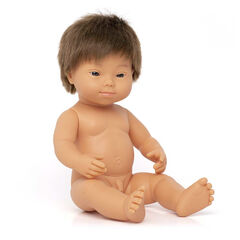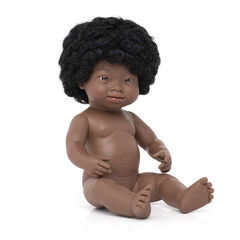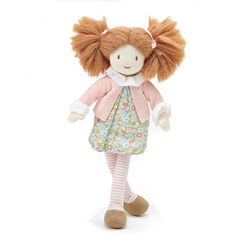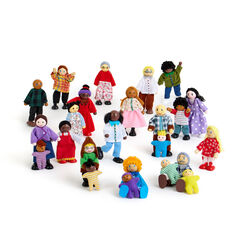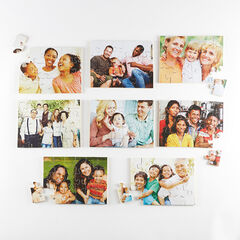Playing with dolls is an integral part of early childhood education. They have been part of children’s play for centuries, providing comfort and companionship along with many opportunities for imaginative exploration.
Dolls are not just an old-faithful resource we expect to see in a setting; they are there for a reason—they serve as a powerful vehicle for learning.
Thoughtfully chosen dolls can support children in developing empathy and communication skills, help them to understand the world around them, and provide rich role play experiences.
In this blog, we’ll look more closely at the following areas:
- The importance of dolls in early childhood education and the skills developed
- Key areas of play where they can be included
- Different types of dolls
- Practical tips
What is the importance of playing with dolls in early childhood education?
Playing with dolls can support children’s development in many ways. Here are some examples of how playing with dolls can benefit children:
Social and emotional development
Young children learn about relationships and emotions by observing the world around them. When they cuddle a doll, pretend to feed it, or comfort it when it’s ‘crying’, they are practising empathy and caring for others.
For example, a child who has recently welcomed a new sibling at home might mirror what they see their parents doing—bouncing the doll gently on their lap and soothing it so it doesn’t cry. In this kind of play, children not only get the opportunity to process their own feelings about big life changes but also gain a sense of control over their own world.
Dolls also help children navigate friendships and interactions. For example, two children may disagree over who gets to push the baby in the pushchair. With gentle guidance, they learn to negotiate and take turns, all important social skills that will help them in later life.
Developing language and communication
Dolls are perfect for promoting conversations, whether this is a child chatting to their doll or role-playing with friends. Children give dolls voices. They create scenarios and mimic everyday conversations they hear from adults.
Imagine children setting up a tea party for their dolls and asking them if they would like more tea or quickly grabbing a cloth and cleaning up a spill. These back-and-forth exchanges build vocabulary, sentence structure, and conversational skills in a natural and engaging way.
For children who are learning English as an additional language (EAL), dolls offer a safe space to practise speaking. A child might not feel confident talking to adults yet, but they might happily chat to a doll, rehearsing words and phrases they have heard.
They can be incorporated when singing nursery rhymes and songs, which are also ‘valuable in supporting early language and communication development’ (National Literacy Trust, 2024). Educators often hear children singing or acting out well-known lullabies or nursery rhymes with their dolls, such as ‘Miss Polly Had a Dolly’, ‘Row, Row, Row Your Boat’, or ‘Rock-a-Bye Baby’.
Encouraging imagination and creativity
Dolls have no set rules – there’s no ‘right’ or ‘wrong’ way to play with them, making them perfect for open-ended, imaginative play.
One day, a doll might be a baby that needs caring for; the next, it could be a superhero saving the world. During this type of play, children learn to think creatively, make up stories and solve problems – important skills for all areas of learning.
Fine and gross motor skills
The simple act of dressing/undressing dolls, brushing their hair, or feeding them with a toy bottle strengthens fine motor skills. Pushing a pram, lifting the baby out of the cot or bathing them will support the development of their gross motor skills. These are important for future writing and independence, for example, using cutlery or buttoning up clothes.
Top tip: Dolls usually end up undressed by the end of the day. Always makes sure they are dressed ready for play the next day, as this means children will have to use their motor skills to take their clothes off again. Also, provide different items/fasteners on clothes and accessories for little fingers to manipulate, such as zips to pull, Velcro to line up and buttons to fasten.

Promoting diversity and inclusion
Dolls can offer children a mirror into their own lives and a window into the lives of others. A setting with a variety of dolls—different skin tones, hair textures, clothing, genders, and abilities—helps children feel represented and included.
For example, a child who wears glasses might feel proud if a doll has glasses, too. Another child might see a doll with a hearing aid and ask questions, sparking a conversation about differences in a natural and age-appropriate way.
Playing with a range of dolls teaches children that people come in all shapes and sizes and that everyone is equally valued.
Preparing for life situations
Dolls can help children prepare for experiences they may face in real life. For example, a child who is anxious about a doctor’s visit might role-play a check-up with their doll, pretending to take its temperature and listen to its heartbeat. This can help them process their emotions and feel more confident when it is their turn.
Similarly, children about to become big brothers or sisters can practise caring for a doll, giving them a sense of what to expect when the new baby arrives.

Examples of play where dolls can be used
Dolls are incredibly versatile and can be incorporated into various play areas within an early years setting. Here are some key areas to consider:
The home corner
The home corner is an ideal space for dolls as it allows children to recreate real-life experiences. They may act out familiar routines such as feeding the baby, putting the baby to bed, or taking the baby for a walk.

Small world play
Figures can be included in small-world play alongside doll houses, miniature furniture, and vehicles. In this space, children often practise storytelling and problem-solving as they create narratives about their dolls’ lives.
Outdoor play
Why restrict playing with dolls to indoors? Give children the opportunity to take them outside for adventures. Children may push their baby in a pram or pushchair, peg out the washing with the doll in a carrier, or even create a pretend picnic. Some children can even be seen strapping their little one on to a bike or into a car, ready for a trip to the local supermarket or seaside.
These scenarios are great for sparking conversations with the children. It encourages children to talk about their own experiences and can also lead to discussions about travelling safely. Outdoor play with dolls can often combine physical activity with imagination and storytelling.
Sensory/wellbeing space
This type of play is great for helping children express and understand emotions. They can be used in discussions about feelings and to help children self-regulate.
For example, an educator might use a doll to model how to support a friend who is sad or a child may seek comfort from the doll if upset.
Different types of dolls
Dolls come in many forms. To provide meaningful and inclusive play experiences, consider the types available in your setting:
Soft-bodied dolls
Soft-bodied dolls made from fabric or plush are ideal for younger children as they offer a comforting, huggable experience and are easy to hold. They help with emotional bonding and are great for bedtime routines in pretend play.
Hard-bodied dolls
Hard-bodied dolls are often more durable and lifelike, meaning they can withstand more active play and can often be bathed, dressed, and moved more easily.

Diversity dolls
Representation matters. Providing dolls with different skin colour, facial features, and hair types helps children see themselves and their peers in their play. Having a range of dolls promotes natural discussions about similarities and differences.
Anatomically correct dolls
Providing anatomically correct dolls can promote discussions and support children in their understanding of similarities and differences between bodies in a natural, age-appropriate way.
Tips and ideas for doll play in your setting
Here are some practical tips to try when using dolls in play:
Provide accessories
To extend play possibilities, offer a variety of props, such as blankets, bottles, clothes, cots, pushchairs, and prams. Alongside props, also re-use real-life accessories such as second-hand baby clothes, teddy bears, rattles, and blankets. This adds authenticity to play and can lead to discussions about their own lives and experiences.
Use dolls in storytelling
Create or read simple stories featuring dolls/babies to help children explore feelings, emotions, and real-life situations. Share books and read stories featuring different characters and family structures that children can incorporate into their play with dolls.

Encourage open-ended play
Allow children to lead their play with dolls rather than directing them towards specific activities. This will give the children time to explore in their own way and can also give educators valuable insight into how the child is thinking or feeling.
Include multi-sensory experiences
For sensory exploration, children can wash dolls in a water tray, wrap them in different fabrics, or use natural scents in the water, such as lemons or soap flakes (risk assessment may be needed). When pretending to feed the babies, why not use this as an opportunity for introducing the children to new foods. and textures?
Music and songs
As stated earlier in the blog, playing with dolls can introduce children to lullabies, action songs and nursery rhymes which are great for developing language skills. Choose some to share with the children so that they can use these in their role play. Why not ask the children if they have any favourites from home which they can share with their peers?
Family dynamics
Display images of different families and caregivers to reinforce inclusivity, real-world connections and belonging. Have a selection of books, posters, jigsaws etc so that children are aware that families are not all the same. By providing these examples, children will be able to have discussions and explore family dynamics in their play.
To read more about the importance of representation through dolls, read Beccie Hawes’ blog – Representation through Dolls and Small World Figures.

Observe and join in the play
Educators can participate in doll play to introduce new language, model empathy, or support children in exploring new social situations.
In summary
So, beneath the simple actions of feeding, dressing, rocking, and caring for a doll lies a world of learning. Children are not only exploring emotions, building relationships, developing language, and practising real-life skills but are also learning how to become caring, empathetic members of society.
Find more dolls and accessories by clicking here
Written by Michelle Reid. Michelle is a mum of one and has over 20 years of experience working as a nursery nurse and qualified teacher.












